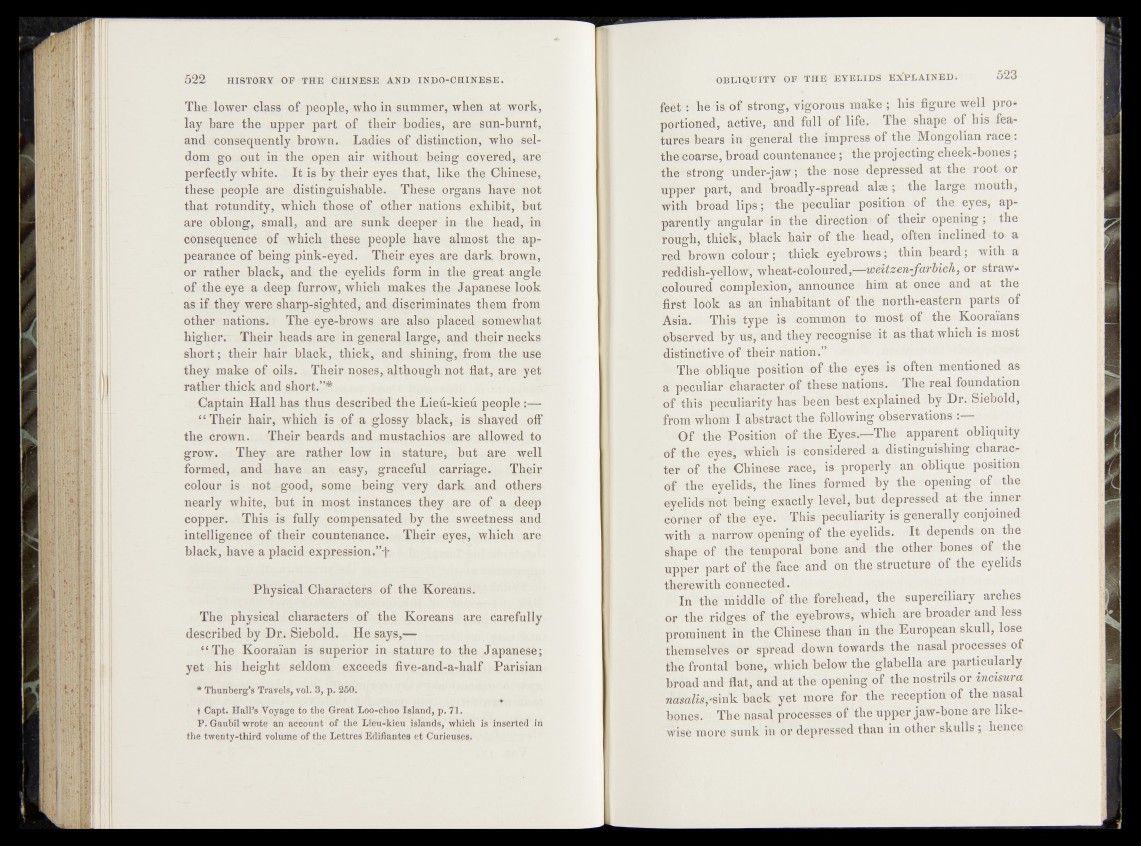
The lower class of people,-who in summer, when at work,
lay hare the upper part of their bodies, are sun-burnt,
and consequently brown. Ladies of distinction, who seldom
go out in the open air without being covered, are
perfectly white. It is by their eyes that, like the Chinese,
these people are distinguishable. These organs have not
that rotundity, which those of other nations exhibit," but
are oblong, small, and are sunk deeper in the head, in
consequence of which thèse people have almost the appearance
of being pink-eyed. Their eyes are dark brown,
or rather black, and the eyelids form in the great angle
of the eye a deep furrow, which makes the. Japanese look
as if they were sharp-sighted, and discriminates them drom
other nations. The eye-brows are also placed somewhat
higherr Their heads are in general large, and their pecks
short; their hair black, thick, and shining,!ftom the use
they make of oils. Their noses, although not flat, are (yet
rather thick and short.”*
Captain Hall has thus described the Lieu-kieu people t—-
“ Their hair, which is of a glossy black, is shaved off
the crown. Their beards and mustachios are allowed to
grow. They are rather low in stature, but are well
formed, and have an easy, graceful carriage. Their
colour is not -good, some being' very dark and others
nearly white, but in most, instances they are of a Meep
copper. This is fully compensated by the sweetness and
intelligence of their countenance. Their eye$, which are
black, have a placid expression.’’f
Physical Characters of the Koreans.
The physical characters of the Koreans are carefully
described by Dr. Siebold. He says,—
“ The Kooraïan is superior in stature fo the Japanese;
yet his height seldom exceeds five-and-a-half Parisian
* Thunberg’s Travels, vol. 3, p. 280.
f Capt. Hall’s Voyage to thf Great Loo-choo Island, p. 71.
P. Ganbil wrote an account of the Lieu-kieu islands, which is inserted in
the twenty-third volume of the Lettres Edifiantes et Curieuses,
feet hè is of strong, vigorous make ; his figure well proportioned,
active^' and full of life. The shape of his features
bears in general the impress of the Mongolian race:
thocoarse, broad countenance; the projecting cheek-bones;
the strong under-jaw; the nose depressed at the root or
upper part, and broadly-spread alee; the large mouth,
with broad lips; - the peculiar position óf the eyes, apparently
angular in the direction of their opening;. the
rough, thick, black fiair of ithe-head, often inclined to a
red brown colour; thick • eyebrows; thin beard; with a
reddish-yellow, wheat-coloured,—weitzm-farbich, or straw-
coloured complexion, announce him at once and at the
first look as a n inhabitant of the north-eastern parts of
Asia. This type is common nto most of the Kooraïans
Óbserved by W, and they recognise it as that which is most
distinctive, of their nation.”
^■‘The oblique position of the-eyes is often mentioned as
a peculiar character of these nations. The real foundation
of this peculiarity has! been best explained by Dr. Siebold,
from #hom I abstract the following observations
Of the Position of the Eyes.—The apparent obliquity
df the dyes, which is • considered a distinguishing character
Of the Chinese race, is properly an oblique position
Of the eyelids, the lines formed by the, opening of the
eyelids not being exactly level, but depressed at the inner
corner of the eye. This peculiarity is generally conjoined
with a narrow opëning of the eyelids. It depends on the
shape of the temporal bone and the other bones of the
upper part of the face and on the structure of the eyelids
therewith connected.
In the middle of the forehead, the superciliary arches
or the ridges of the eyebrows, which are broader and less
prominent in the Chinese than in the European skull, lose
themselves or spread down towards the nasal processes of
the frontal bone, which below the glabella are particularly
broad and flat, and at the opening of the nostrils or incisura
nasalisssmk back yet more for the reception of the nasal
bones. The nasal processes of the upper jaw-bone are likewise
more sunk in or depressed than in other skulls; hence